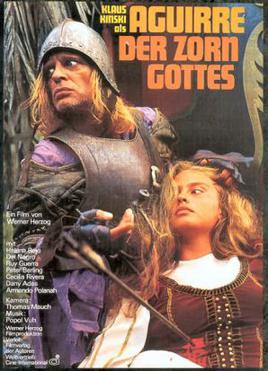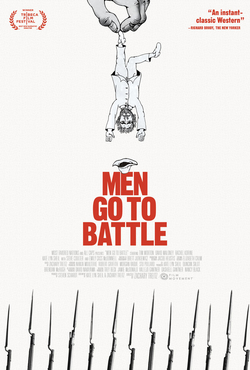
“Aguirre,
Wrath of God” is a West German film by Werner Herzog (“Rescue Dawn”). The movie is best known for the collaboration
of Herzog with Klaus Kinski. This was
the first of their five movies together and they had one of the weirdest
relationships in cinema history. Kinski
was mentally unstable individual and the
circumstances under which the movie was made were not exactly conducive to
stability. Herzog insisted on filming on
location in the rainforest of Peru. His
small crew of eight and his cast had to climb mountains, cut paths through the
jungle, and raft down rivers and over rapids.
And without the comforts that a big budget might have provided. The movie cost only $370,000 to make (and
one-third of that was Kinski’s salary).
Part of that money went to a monkey catcher (the movie has a memorable
scene involving a raft-load of monkeys).
When the contractor betrayed Herzog and was going to ship the monkeys to
a buyer in America, Herzog intercepted them at the airport. Pretending to be a vet, Herzog made off with his
simian actors and later set them free.
If the lack of funds and biting monkeys were not enough to insure a
difficult shoot, you had Kinski involved.
He and Herzog disagreed violently on how to portray Aguirre. Kinski wanted to play himself,
basically. Herzog wanted Aguirre to be
more sane. To get the performance he
wanted he would rile up Kinski and let him exhaust himself and then roll the
camera. That worked on set, but when
they weren’t filming there was the problem with dealing with the unlensed
Kinski. At one point, Klaus fired three
shots at a noisy tent and took off the finger tip of an extra. Another time, Kinski was preparing to leave
because he wanted a crew member fired.
Herzog pulled a gun and threatened to kill Kinski and himself if he
left. And yet, these two made four more
movies together! Not that Herzog is the
most normal director either. He wrote
the script after reading about the real Aguirre in a book about
adventurers. He completed the script in
two-and-a-half days. Part of the writing
occurred on a drunken bus ride with his soccer team. At one point, a teammate vomited on several
pages which Herzog proceeded to throw out the window. This resulted in a gap in the original
version of the story.
The
movie is set in South America in 1560.
“After the fall of the Incan Empire, the Indians conned the Spanish into
believing there was an El Dorado in the Amazon basin.” An expedition of
conquistadors moves through the jungle to find this city of gold. Gonzalo Pizarro, half-brother of the famous
conqueror of the Inca, leads the expedition.
However, the lack of supplies and the difficulties that still lay ahead
cause him to reconsider the march. He
decides to send a group of forty ahead to reconnoiter and report back the
feasibility of proceeding on. He
appoints Don Pedro de Ursua (Ruy Guerra) to command. Don Lope de Aguirre is his
second-in-command. They bring Ursua’s
mistress Dona Ines (Helena Rojo) and Aguirre’s fifteen year-old daughter Flores
(Cecilia Rivera) . Accompanying them is
our narrator Brother Gaspar de Carvajal (Del Negro). The motley crew is travelling by rafts. It is not a pleasure cruise. Not only is Mother Nature against them, but
the natives are not welcoming. When
Ursua cools to the prospects of gold and glory, Aguirre overthrows him and
declares a fat slob named Guzman to be the Emperor of Peru. They continue on with Aguirre becoming
increasingly megalomaniacal.
“Aguirre,
Wrath of God” is an acclaimed movie. It
is considered to be one of the great cult films. Many critics place it among the best movies
ever made. It is certainly one of the
most unusual movies ever made. If you
take away the involvement of Herzog and Kinski, I would doubt it would be the
must-see film that it surely is. Be
aware that if you are not a cinephile, the movie might leave you scratching
your head. The cinematography is
mesmerizing. Herzog’s use of hand-held
cameras for the raft scenes gives you the feeling that you are on board. This can be disconcerting when the rafts are
braving the rapids, but a lot of the journey is on a slow-moving Amazon. The river moves slow and so does the
movie. The movie seems longer than it is
and some of the scenes tend to drag. It
is obvious from the start that the plot will be a series of escalating
calamities hosted by a mad man, so it is not exactly a feel-good film. The entertainment is provided by watching the
performance of Kinski. Just his facial
expressions alone are worthy of the cult following. Aside from him, the rest of the cast does not
stand out. How could they when Kinski
was sucking all the air out of the jungle?
This was Cecilia Rivera’s only film.
One wonders if her experience playing opposite Kinski soured her on the
profession. Another thing the movie is
memorable for is the unusual sound track provided by the progressive/Krautrock
band Popol Vuh. It is choir-like and
surreal. The kind of music you could
imagine Herzog playing on a boom box as the cast and crew labored through the
jungle.
“Aguirre,
Wrath of God” is not really a war movie although it did influence Coppola’s
“Apocalypse Now”. It also has a touch of
the ‘lost patrol” subgenre to it. I
recommend you watch it if you love movies in general. Just be aware that it is overrated as
entertainment.
GRADE = B-
HISTORICAL ACCURACY: Surprisingly,
the movie is fairly accurate. Herzog has
melded two different tales. In 1541, Gonzalo Pizarro
sent a small force under Francisco de Orellana to scout ahead for El
Dorado. Orellana’s small force forged
ahead on a small ship. On board was a Dominican
named Gaspar de Carvajal who kept a journal.
The real Carvajal was not the Indian-hater of the film and in fact, was
sincerely interested in their conversion.
Orellana and his men disappeared into the jungle and were presumed lost,
but eventually sailed all the way down the Amazon to the Atlantic.
In
1560, the governor of Peru commissioned an expedition to explore for El
Dorado. It was led by Ursua and included
his mistress Dona Inez. His second in
command was Aguirre who brought his teenage daughter Flores. Along the way, Aguirre decided to take over
and murdered Ursua. He proclaimed a man
named Fernando to be “Prince of Peru”.
Later, when Fernando balked at Aguirre’s goal of conquering Panama and
Peru, Aguirre killed him, too. By this
time, Aguirre insisted on being called “Wrath of God, Prince of Freedom, and
King of Tierra Firme.” Others called him
“El Loco”. Aguirre and his men made war
on the natives as they passed through.
When they reached the Atlantic, they captured Isla Margarita off the
coast of Venezuela and killed much of the population. This notorious conquistador was worse than in
the movie, believe it or not. His
treasonous activities had reached the Crown and the government offered a pardon
to Aguirre’s men if they would turn on him.
They did. Before he was captured
and executed, Aguirre killed Flores.



.jpg)

